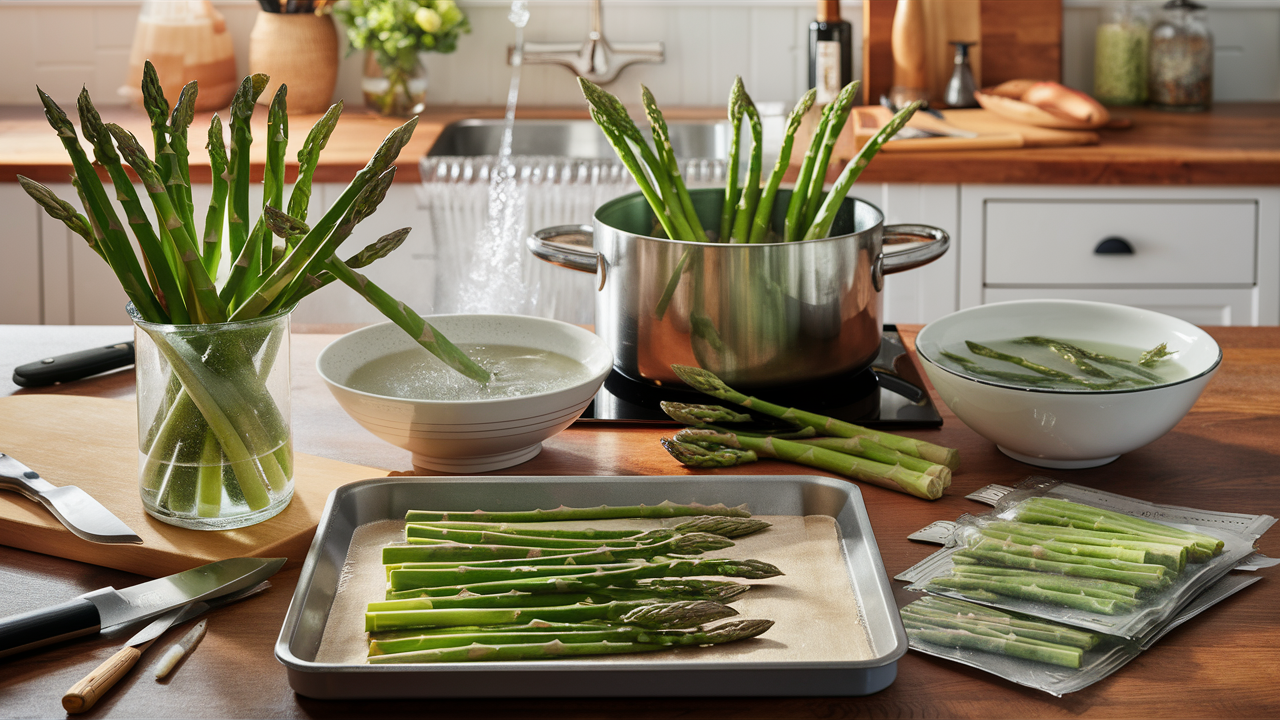If you’ve ever found yourself with more asparagus than you know what to do with—whether it’s a farmers’ market haul or a great grocery store deal—you’re not alone. The good news is that freezing asparagus is a simple, smart way to preserve its fresh flavor and make sure none of it goes to waste.
Yes, freezing asparagus takes a little effort, but it’s worth it when you can toss some into a stir-fry or roast a batch long after the season has ended. Let’s break down the process step by step so you can enjoy asparagus all year long.
Why Freeze Asparagus?
Here’s the thing: asparagus doesn’t have a long shelf life. Even when stored in the fridge, it starts to lose its vibrancy and crispness within days. Freezing it allows you to:
- Save Money: Take advantage of sales or a bumper crop without worrying about spoilage.
- Reduce Waste: No more tossing asparagus into the compost because you didn’t get to it in time.
- Enjoy Convenience: Having frozen asparagus on hand makes it easy to whip up a quick meal without a trip to the store.
Picking the Best Asparagus to Freeze
Not all asparagus is ideal for freezing, so it’s important to start with the right batch. Look for stalks that are:
- Fresh and Firm: Avoid wilted or rubbery asparagus.
- Bright Green: This indicates freshness and flavor.
- Uniform in Size: Freezing similar-sized stalks ensures they’ll cook evenly later.
If your asparagus is thicker, consider peeling the tough outer layer near the base to improve texture after freezing.
How to Freeze Asparagus: Step-by-Step
Freezing asparagus isn’t rocket science, but there are a few tricks to get the best results.
Step 1: Wash and Trim
Rinse your asparagus thoroughly under cold water to remove any dirt or residue. Snap off the woody ends by bending the stalks—they’ll naturally break where the tender part begins.
Step 2: Sort by Thickness
Grouping stalks by size makes blanching more efficient. Thin stalks need less time than thicker ones, so separating them saves you from overcooking or undercooking some.
Step 3: Blanch the Asparagus
Blanching is the secret to freezing asparagus that still tastes fresh and looks vibrant. Here’s how to do it:
- Bring a large pot of water to a rolling boil.
- Prepare a bowl of ice water nearby.
- Drop the asparagus into the boiling water. Blanch thin stalks for 1-2 minutes, medium stalks for 2-3 minutes, and thick stalks for 4 minutes.
- Quickly transfer the asparagus to the ice water to stop the cooking process. Let them chill for the same amount of time they were in the boiling water.
Step 4: Drain and Dry
Drain the asparagus well and pat it dry with a clean kitchen towel. Any excess moisture can lead to ice crystals or freezer burn, so don’t skip this step.
Step 5: Flash Freeze
Arrange the asparagus in a single layer on a baking sheet, making sure the stalks aren’t touching. Freeze them for 1-2 hours until firm. This prevents the stalks from clumping together later.
Step 6: Pack and Store
Transfer the frozen asparagus to freezer bags or airtight containers. Remove as much air as possible to prevent freezer burn, and label the bags with the date. Store them in the freezer for up to 8 months.
Using Frozen Asparagus
Frozen asparagus is a versatile ingredient that works well in a variety of dishes. Keep these tips in mind:
- No Need to Thaw: For most recipes, like stir-fries or soups, you can toss frozen asparagus straight into the pan or pot.
- For Roasting: If you want to roast frozen asparagus, thaw it slightly and pat it dry to avoid excess water on the baking sheet.
- Blend It Up: Frozen asparagus is perfect for creamy soups, purees, or even green smoothies.
Storage Tips for Better Results
- Label Clearly: Write the date on your bags so you can keep track of freshness. Frozen asparagus is best used within 6-8 months for optimal flavor.
- Use a Vacuum Sealer: If you have one, vacuum-sealing can extend the storage life by removing all air.
- Don’t Overfill Bags: Leave enough room for the asparagus to lay flat, which helps avoid clumping.
Frequently Asked Questions
Can I freeze asparagus without blanching?
Technically, yes, but it’s not ideal. Blanching preserves the color, texture, and flavor of asparagus, making it worth the extra step.
How long does frozen asparagus last?
While asparagus can technically stay frozen for up to a year, it’s best used within 6-8 months to ensure the best taste and texture.
Can I freeze cooked asparagus?
Yes, but keep in mind that cooked asparagus will be softer after freezing. It’s best for soups or casseroles rather than dishes where you want a firmer texture.
Why Freezing Asparagus is Worth It
Freezing asparagus is one of those little kitchen hacks that saves you time, money, and stress. Instead of rushing to use up fresh asparagus before it wilts, you can enjoy its flavor and nutrients anytime you want.
So the next time you’re staring at a bundle of asparagus and wondering how you’ll eat it all, don’t overthink it. With just a little effort, your freezer can become a stash of ready-to-use asparagus, waiting to brighten up your next meal.

